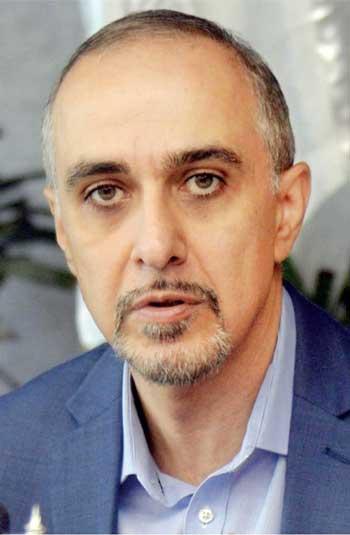11 Oct 2024 - {{hitsCtrl.values.hits}}
 |
|
Gevorg Sargsyan Pic by Pradeep Pathirena |
By Nuzla Rizkiya
Sri Lanka’s untapped export potential has grown to an estimated US$ 10 billion annually, according to the World Bank, signalling missed opportunities for economic growth.
The World Bank’s bi-annual Sri Lanka Development Update titled ‘Opening Up to the Future’ suggests that by tapping into this potential, the country could create around 142,500 new jobs and generate US$ 10 billion in net inflows, boosting the economy significantly.
This marks a sharp rise from the US$ 7.4 billion estimated by the World Trade Organization in 2020, reflecting a worrying trend in Sri Lanka’s export performance.
According to the World Bank, Sri Lanka trails behind its peers in East and South Asia across various manufacturing subsectors, with the exception of clothing and rubber products, where exports meet expectations.
In other areas, however, the country is falling short of its potential, with the World Bank labeling these shortfalls as “missing” exports.
Addressing a press conference marking the release of the report, World Bank Group Country Manager for Sri Lanka Gevorg Sargsyan stressed that exports play a crucial role for Sri Lanka’s sustained recovery. He noted that the country is losing out on lucrative opportunities in sectors such as tourism, which holds significant untapped potential.
“Export is one of the biggest areas for sustainable growth. So untapping this export potential to move forward is critical. I very much hope that the leadership of the country and all the stakeholders come together and make sure that the country finally starts moving in that direction,” Sargsyan said.
The Institute of Policy Studies (IPS) recently validated this stance in its latest ‘State of the Economy’ report, which indicated significant potential particularly for minor agricultural crops in Sri Lanka that have shown a notable upward trajectory in recent trade.
These include products such as coconuts and cinnamon, which, according to the World Bank update, exhibit a strong Revealed Comparative Advantage (RCA) in global markets while showing greater potential for value chain development.
However, to untap these opportunities, Sri Lanka must urgently implement a series of reforms to address its ‘anti-export bias’ especially in terms of its inward-looking protectionist policies.
The World Bank report listed several key factors hindering export growth, including policy uncertainty, complicated tariff structures and the country’s dominant reliance on a narrow range of exports.
Additionally, low investments in value-added service sectors such as tourism and the lack of product diversification, especially in high-growth sectors like machinery, have stifled Sri Lanka’s ability to fully tap into its export potential.
To counter these challenges, the World Bank also recommends several critical reforms, notably the implementation of a National Single Window (NSW) to streamline international trade processes.
Other recommendations include the revamping of Sri Lanka’s Foreign Direct Investment (FDI) regime through the operationalisation of Economic Transformation Act (ETA), signing deep trade agreements and enacting complementary policies related to digital connectivity and labour market flexibility.
As of August 2024, Sri Lanka has recorded cumulative export revenue of US$10.69 billion, marking a 5.82 percent increase compared to the same period in 2023.
07 Jan 2025 7 hours ago
07 Jan 2025 7 hours ago
07 Jan 2025 8 hours ago
07 Jan 2025 07 Jan 2025
07 Jan 2025 07 Jan 2025